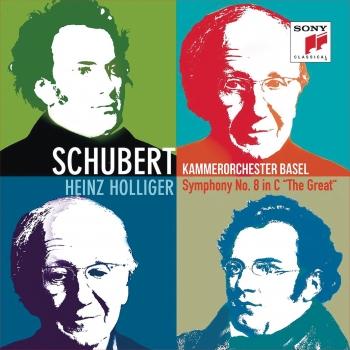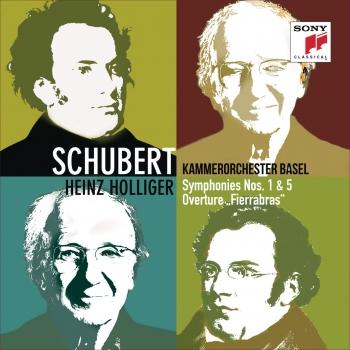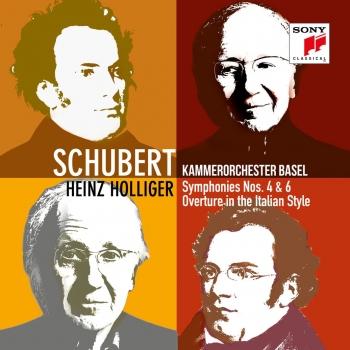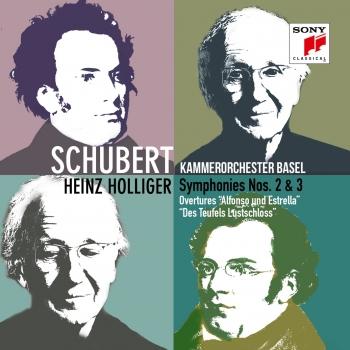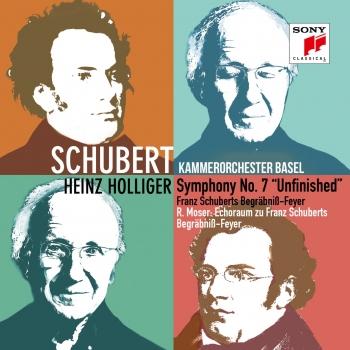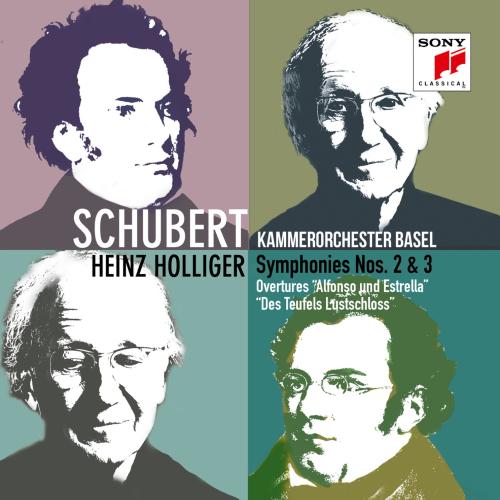
Schubert: Symphonies Nos. 2 & 3 Kammerorchester Basel & Heinz Holliger
Album info
Album-Release:
2020
HRA-Release:
13.11.2020
Label: Sony Classical
Genre: Classical
Subgenre: Orchestral
Artist: Kammerorchester Basel & Heinz Holliger
Composer: Franz Schubert (1797-1828), Heinz Holliger (1939)
Album including Album cover Booklet (PDF)
I`m sorry!
Dear HIGHRESAUDIO Visitor,
due to territorial constraints and also different releases dates in each country you currently can`t purchase this album. We are updating our release dates twice a week. So, please feel free to check from time-to-time, if the album is available for your country.
We suggest, that you bookmark the album and use our Short List function.
Thank you for your understanding and patience.
Yours sincerely, HIGHRESAUDIO
- Franz Schubert (1797 - 1828): Symphony No. 3 in D Major, D. 200:
- 1 Franz Schubert: Symphony No. 3 in D Major, D. 200: I. Adagio maestoso - Allegro con brio 09:37
- 2 Franz Schubert: Symphony No. 3 in D Major, D. 200: II. Allegretto 04:26
- 3 Franz Schubert: Symphony No. 3 in D Major, D. 200: III. Menuetto. Vivace 04:07
- 4 Franz Schubert: Symphony No. 3 in D Major, D. 200: IV. Presto vivace 06:38
- Franz Schubert:
- 5 Franz Schubert: Des Teufels Lustschloß, D. 84: Overture 08:58
- 6 Franz Schubert: Alfonso und Estrella, D. 732: Overture 07:10
- Symphony No. 2 in B-Flat Major, D. 125:
- 7 Franz Schubert: Symphony No. 2 in B-Flat Major, D. 125: I. Largo - Allegro vivace 14:41
- 8 Franz Schubert: Symphony No. 2 in B-Flat Major, D. 125: II. Andante 08:13
- 9 Franz Schubert: Symphony No. 2 in B-Flat Major, D. 125: III. Menuetto: Allegro vivace - Trio 03:10
- 10 Franz Schubert: Symphony No. 2 in B-Flat Major, D. 125: IV. Presto 08:59
Info for Schubert: Symphonies Nos. 2 & 3
This recording was made as part of the complete recording of Franz Schubert’s symphonies with the Basel Chamber Orchestra conducted by Heinz Holliger.
Schubert wrote his Third Symphony in barely two months in the early summer of 1815. He had completed his monumental Second Symphony only a short time earlier. His Third is a bright and highly sophisticated piece with almost crystalline textures in its inner movements. In its opening movement Schubert essays a technique that he not attempted before and creates a structural link between the slow introduction and the first subject. As a result, the music of the slow introduction no longer belongs to another, eerily unfathomable world, as it had done in the case of the First and Second Symphonies, but is integrated into the musical argument. It also introduces the recapitulation. In consequence the Third Symphony gives the impression of being more “of this world” and of seeming less labyrinthine than the Second.
The other movements are likewise characterized by their sense of clarity. The second strikes a songlike note. While he was working on it, Schubert kept altering the tempo marking, gradually increasing its speed and finally turning it into an Allegretto. The seemingly simple melody is constantly repeated, but on each occasion it is lit from a different angle. The result recalls a merry-go-round. In Heinz Holliger’s interpretation, the songlike element acquires an almost glasslike quality, suggesting a carousel of porcelain figurines. The third and fourth movements are often overdriven in a way reminiscent of Beethoven, in the process acquiring an air of bombast. Holliger avoids this approach and brings a much greater focus to both movements, allowing their intricacies and their unique qualities to appear as if under a magnifying glass. The third movement is a Menuetto and as such is no Beethovenian Scherzo. Its Trio is agogically very free, with a tempo marking almost the same as that of the rest of the movement. In the fourth movement Holliger stresses the dancelike element: the quick tempo and the feathery-light and at the same time very clear accents invest the music with a distinctly
Hungarian character.
Kammerorchester Basel
Heinz Holliger, conductor
Heinz Holliger
was born in Langenthal (Switzerland, canton of Berne) on 21 May 1939. During his grammar-school education he already studied oboe with Emile Cassagnaud at the Conservatoire of Berne and composition with Sándor Veress. From 1958 he continued his studies with Yvonne Lefébure (piano) and Pierre Pierlot (oboe) in Paris. Between 1961 and 1963 he studied composition with Pierre Boulez at the Music Academy of Basel. After winning first prizes at international music competitions (Geneva 1959, International Music Competition of the ARD 1961), Holliger began to give worldwide concert performances as an oboist. Contemporary composers such as Hans Werner Henze, Krzysztof Penderecki, György Ligeti, Elliott Carter, Witold Lutoslawski, Karlheinz Stockhausen, and Luciano Berio wrote compositions specially for him. Among his outstanding achievements is the rediscovery of forgotten works by 18th-century composers such as Jan Dismas Zelenka and Ludwig August Lebrun.
Holliger's oeuvre covers all genres – from stage works via orchestral, solo and chamber music works to numerous vocal pieces. Almost all compositions bear testimony to a tireless search for the limits of sound and language. His music is often preceded by an intensive examination of artists' or poets' lives and lyrical texts. He has always been fascinated by artists living on the edge of society or at the edge of life. At this point, the Scardanelli Cycle (1975-85) has to be emphasized, in which Holliger turns the last poems of Friedrich Hölderlin into a cycle of 2.5 hours duration for different instrumentations. For this work, the composer was awarded the Premio Abbiati of the Biennale di Venezia in 1995. In Gesänge der Frühe for choir, orchestra and tape, premiered in 1988, Heinz Holliger combined poems by Friedrich Hölderlin with music by Robert Schumann. In the two song cycles Drei Liebeslieder (1960) and Fünf Lieder (1992-2006) for contralto voice and orchestra, he concentrated on poems by Georg Trakl. In the cycle Glühende Rätsel for contralto voice and 10 instrumentalists (1964) Holliger set verses by Nelly Sachs to music. Even poems by Christian Morgenstern were set to music by Heinz Holliger (Sechs Lieder for soprano and orchestra, composed in 1956/57, orchestrated in 2003).
For the stage, Holliger wrote the opera Schneewittchen which was premiered at the Zurich Opera in 1998. The composer adapted the text from the work of Robert Walser in which, in contrast to Grimm's fairytale, the shadows of the characters meet after the actual story. The ECM recording of Schneewittchen won a Grammy Award in 2002. The examination of texts by Samuel Beckett resulted in the composition of three other short stage works: Come and go (1976/77), Not I (1978-80), and What Where (1988).
Holliger's concert pieces too often refer to biographies or literary works: Concerto 'Hommage à Louis Soutter' for violin and orchestra (1993-95, revised 2002) portrays the life of the Swiss painter. In Siebengesang (1966/67) for oboe, orchestra, singing voices and loudspeaker, he incorporates a poem by Georg Trakl. Holliger has composed numerous chamber music works, including the early wind quintet h (1968), Romancendres for violoncello and piano (2003), Contrechant sur le nom de Baudelaire for (bass) clarinet (2008) as well as two string quartets and solo pieces for almost every instrument.
Holliger has been awarded many awards and prizes: the Frankfurt Music Award 1988, the Ernst von Siemens Music Award 1991, the Prix de Composition Musicale de la Fondation Prince Pierre de Monaco for (S)irató 1994, to name but a few. In 2007 Holliger was the first to receive the Zurich Festival Award, in 2008 he received the Rheingau Musikpreis, and will be awarded the Robert-Schumann-Preis of the City of Zwickau in 2017. He was composer-in-residence of the Orchestre de la Suisse Romande and the International Music Festival in Lucerne. In April 2003 the Cité de la Musique in Paris dedicated a whole concert week to the composer, conductor and oboist Holliger. With projects such as the Basler Musikforum cofounded by him in 1987 and cooperations with the Junge Deutsche Philharmonie and the Ensemble Modern, Holliger is particularly involved in the presentation of new music.
Booklet for Schubert: Symphonies Nos. 2 & 3










